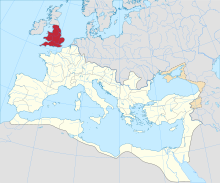| Boudican revolt | |||||||
|---|---|---|---|---|---|---|---|
| Part of Roman conquest of Britain | |||||||
 The Roman province of Britain (red), where the revolt took place. The Roman Empire is in white. | |||||||
| |||||||
| Belligerents | |||||||
| Roman Empire |
Iceni Trinovantes Other Celtic Britons | ||||||
| Commanders and leaders | |||||||
| Gaius Suetonius Paulinus | Boudica | ||||||
| Strength | |||||||
| 10,000 | 230,000 (Cassius Dio) | ||||||
| Casualties and losses | |||||||
| 400 | 80,000 (Cassius Dio) | ||||||
| 70,000–80,000 civilians killed[1][2] | |||||||
The Boudican revolt was an armed uprising by native Celtic Britons against the Roman Empire during the Roman conquest of Britain. It took place circa AD 60–61 in the Roman province of Britain, and it was led by Boudica, the Queen of the Iceni tribe. The uprising was motivated by the Romans' failure to honour an agreement they had made with Boudica's husband, Prasutagus, regarding the succession of his kingdom upon his death, and by the brutal mistreatment of Boudica and her daughters by the occupying Romans.
Although heavily outnumbered, the Roman army led by Gaius Suetonius Paulinus decisively defeated the allied tribes in a final battle which inflicted heavy losses on the Britons. The location of this battle is not known. It marked the end of resistance to Roman rule in most of the southern half of Great Britain, a period that lasted until AD 410.[3] Modern historians are dependent for information about the uprising and the defeat of Boudica on the narratives written by the Roman historians Tacitus and Dio Cassius, which are the only surviving accounts of the battle known to exist.[4]
- ^ Tacitus, Annals 14.33
- ^ Henshall, K. (2008). Folly and Fortune in Early British History: From Caesar to the Normans. Springer. p. 55. ISBN 978-0230583795.
- ^ Webster, Graham (1978). Boudica the British revolt against Rome AD 60. London: Routledge. ISBN 0415226066.
- ^ Bulst, Christoph M. (October 1961). "The Revolt of Queen Boudicca in A.D. 60". Historia: Zeitschrift für Alte Geschichte. 10 (4): 496–509. JSTOR 4434717.